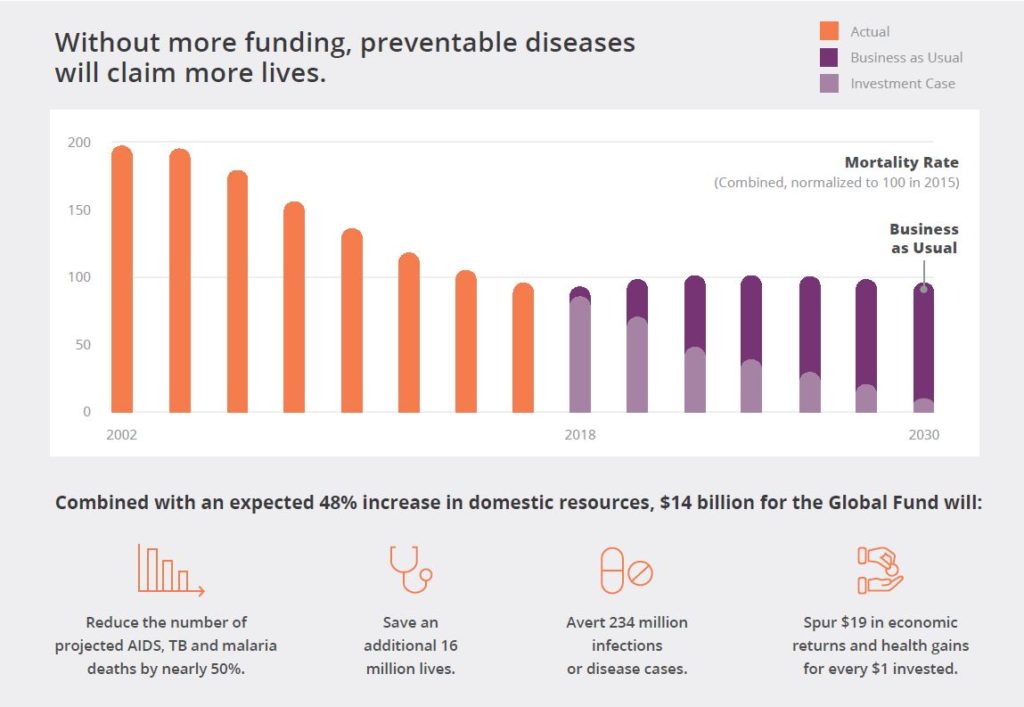The end of HIV, tuberculosis, and malaria is possible – but we’re off track
Just twenty years ago, HIV/AIDS, tuberculosis, and malaria were wreaking havoc on populations across the globe, killing millions in a worldwide crisis.
But the world came together to change the future. Pooling its resources, countries created the Global Fund to Fight AIDS, Tuberculosis and Malaria. Now almost two decades later, that international partnership has helped save 27 million lives.
In the State of the Union this year, the President pledged that “together we will defeat AIDS in America and beyond.” But then a few weeks later, the White House proposed slashing funding for the Global Fund – one of the most powerful tools we have against the disease. As world leaders come together later this year to make new commitments to the Global Fund, it’s no time for retreat.
U.S. support for the Global Fund has always been uniquely bipartisan, crossing party lines when often not much else could. Though the control of Congress and the White House has shifted back and forth between parties over the last 17 years, U.S. support for the Global Fund has remained constant.
The Global Fund has a new plan that will support countries to save 16 million more lives in the three years ahead. But it will take at least $14 billion in new investment to make it possible. The U.S. must continue its strong support, recommitting to provide a third of the total needed.
The Global Fund operates on a massive scale, but it remains effective because it’s structured as an innovative partnership between governments, civil society, the private sector, and people affected by the diseases. Together, this partnership works to get treatment, prevention, and care to people who need it. In 2017 alone, countries supported by the Global Fund provided HIV antiretroviral therapy for 17.5 million people, while 5 million people got treatment for TB, and 108 million got treated for malaria.
Coupled with additional public health investments from numerous countries, the elimination of these diseases as a public health threat is within our grasp, if we commit the resources needed to get there.
What’s at risk
The progress in the fight against AIDS, TB, and malaria has been nothing short of remarkable, but threats remain:
- Progress against malaria is stalling, with the number of global cases now rising. Meanwhile, resistance to drugs and insecticides presents a growing threat in regions hardest hit by the disease.
- Tuberculosis remains the world’s biggest infectious killer, despite being preventable, treatable, and curable. Public health systems fail to reach a full third of all people who fall sick with TB each year.
- The world is sadly off-track in the fight against HIV/AIDS. A failure to tackle stigma and discrimination associated with the disease has halted progress against new infections and deaths among marginalized groups, including adolescent girls and young women.
Despite these setbacks, the science shows we can still end these epidemics by 2030. The Global Fund is the catalyst to make it happen.
MORE ON HIV/AIDS MORE ON TB MORE ON MALARIA
Will we step up or slip back?
The Global Fund now has a plan to support countries to save 16 million lives in the next three years (2020-22). A $14 billion investment is the minimum needed to get back on track toward ending the epidemics. And there is no simple “maintenance” option; without this new investment, these diseases will claim more lives.

Credit: Friends of the Global Fight
With a commitment of $14 billion from donor governments over the next three years, the Global Fund will support countries to:
- Save 16 million lives
- Cut the death toll in half
- Stop 234 million infections or cases of HIV, TB, and malaria
- Unlock an additional $46 billion in funding from lower-income countries fighting these epidemics
READ THE GLOBAL FUND INVESTMENT CASE
The U.S. must do its part
With the Global Fund, the world is again looking to the United States for leadership. Since the beginning, the U.S. has led the effort on the Global Fund, providing a full one-third of its financial resources. That must continue, with the U.S. coming to the table with at least $4.68 billion toward the $14 billion minimum target.

Credit: Friends of the Global Fight
For years, our leaders have recognized that investing in fighting these diseases around the world is not only the right thing to do, it’s also the smart thing to do. Malaria-free countries show economic growth five times greater than countries with malaria. And every $1 invested in the Global Fund spurs $19 in economic returns and health gains. Investing in local health infrastructure is a core function of the Global Fund. Not only does this stop the spread of AIDS, TB, and malaria, it also helps prevent outbreaks of other infectious diseases, such as Ebola, from getting out of hand.
World leaders will gather in October to make commitments toward the $14 billion minimum goal. The U.S. needs to be there, recommitting to this fight. We have the chance to make history by ending these infectious killers. Let’s not waste it.
More background:
Global Fund Case for Investment Summary
Stories of the Global Fund partnership
How the Global Fund partners with U.S. AIDS, TB and malaria programs
DOWNLOAD A PDF COPY OF THIS MEMO
Media contact:
Colin Smith
[email protected]
+1 202.783.4800 x139